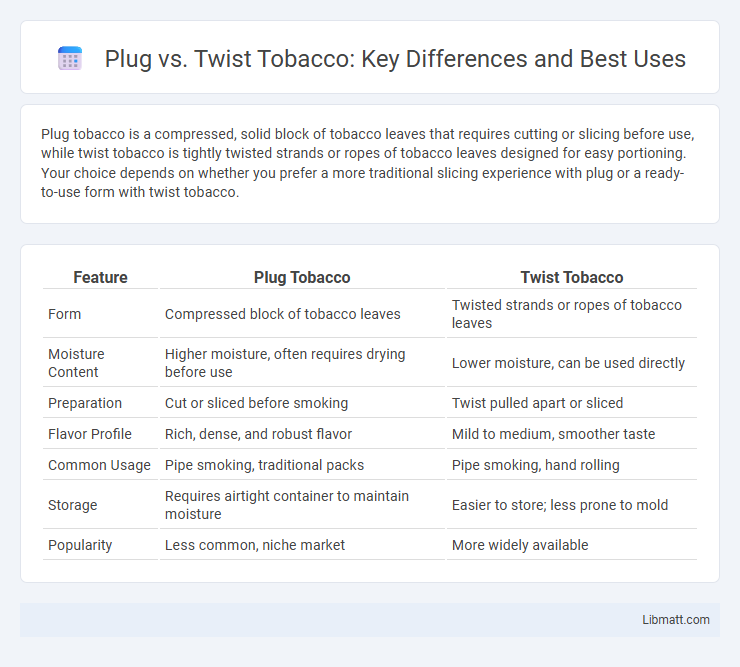Plug tobacco is a compressed, solid block of tobacco leaves that requires cutting or slicing before use, while twist tobacco is tightly twisted strands or ropes of tobacco leaves designed for easy portioning. Your choice depends on whether you prefer a more traditional slicing experience with plug or a ready-to-use form with twist tobacco.
Table of Comparison
| Feature | Plug Tobacco | Twist Tobacco |
|---|---|---|
| Form | Compressed block of tobacco leaves | Twisted strands or ropes of tobacco leaves |
| Moisture Content | Higher moisture, often requires drying before use | Lower moisture, can be used directly |
| Preparation | Cut or sliced before smoking | Twist pulled apart or sliced |
| Flavor Profile | Rich, dense, and robust flavor | Mild to medium, smoother taste |
| Common Usage | Pipe smoking, traditional packs | Pipe smoking, hand rolling |
| Storage | Requires airtight container to maintain moisture | Easier to store; less prone to mold |
| Popularity | Less common, niche market | More widely available |
Introduction to Plug and Twist Tobacco
Plug tobacco is a compressed block of tobacco leaves, often pressed with flavors and moisture, designed for slow, controlled use, while twist tobacco consists of long, braided strands of cured tobacco that can be sliced or shredded before use. Both forms offer distinct preparation and flavor experiences, with plug tobacco providing a denser, often more potent option and twist tobacco delivering a traditional, rustic texture. Understanding these differences helps you select the right tobacco type to suit your preference and smoking style.
Historical Background of Plug and Twist Tobacco
Plug and twist tobacco trace their origins to the 17th century, with plug tobacco emerging as a compressed block for easy transport and later sliced or chewed, popular among American colonists and soldiers. Twist tobacco originated in England, where leaves were twisted into rope-like shapes for prolonged freshness and convenience, gaining traction among sailors and rural communities. Both forms reflect historical preservation methods and cultural preferences in tobacco consumption across different regions.
What is Plug Tobacco?
Plug tobacco is a traditional form of smokeless tobacco made by pressing shredded tobacco leaves into a dense, compact block or "plug." It requires cutting or slicing before use and offers a longer-lasting flavor compared to loose or twist tobacco varieties. Your choice of plug tobacco provides a rich, slow-burning experience preferred by many seasoned users for its robust taste and ease of storage.
What is Twist Tobacco?
Twist tobacco is a traditional form of chewing tobacco made by pressing and twisting moist shredded tobacco leaves into tight, rope-like strands. Unlike plug tobacco, which is compressed into dense blocks, twist tobacco retains a more flexible, braided texture that allows users to cut or bite off desired portions. Its natural aging process enhances flavor and smoothness, offering a distinct chewing experience favored by some tobacco connoisseurs.
Key Differences Between Plug and Twist Tobacco
Plug tobacco is compressed and sliced into chunks, offering a denser, slower-burning smoke ideal for pipe smokers seeking long-lasting flavor. Twist tobacco comes in tightly braided ropes or twists, providing a firm, moist texture that requires cutting or unraveling before use, commonly favored for chewing or rolling. The primary differences lie in their preparation, texture, and typical consumption methods, with plug being more solid and twist more flexible and fibrous.
Flavor Profiles: Plug vs Twist Tobacco
Plug tobacco offers rich, robust flavor profiles with deep earthy and smoky notes, often infused with natural sweeteners like molasses or maple syrup to enhance its complexity. Twist tobacco, characterized by its distinctive spiral shape, delivers a bolder, more intense taste experience with pronounced spiciness and aromatic woody undertones. Both types boast unique flavor dimensions favored by pipe smokers seeking distinct sensory experiences with naturally rich tobacco blends.
Preparation and Usage Methods
Plug tobacco requires cutting or slicing into smaller pieces before use, often by hand or with a specialized knife, making it denser and slower-burning. Twist tobacco is pre-twisted into a rope-like shape, allowing users to break off portions easily without additional preparation, offering convenience for quick packing. Both forms are typically used for chewing or pipe smoking, with the choice depending on user preference for preparation effort and smoke consistency.
Advantages and Disadvantages of Each Type
Plug tobacco offers a compact, long-lasting form with a slow burn, making it efficient for extended use but can be tough to prepare and may feel harsh to beginners. Twist tobacco is easier to handle and often considered smoother in taste, yet it tends to burn faster and may dry out quicker, requiring more frequent replacement. Both types cater to different user preferences in flavor intensity and smoking duration, impacting their overall experience and maintenance.
Popular Brands and Varieties
Popular plug tobacco brands include Stoker's, Lee, and Copenhagen, known for their moist, compressed tobacco blocks favored for long-lasting use. Twist tobacco varieties, such as those offered by Samuel Gawith and Gawith Hoggarth, consist of hand-rolled rope or ribbon-shaped strands prized for their slow-burning qualities and rich flavor profiles. Consumers often choose plug for its convenience and dense packing, while twist appeals to those seeking a traditional smoking experience with customizable cuts.
Choosing Between Plug and Twist Tobacco
Choosing between plug and twist tobacco depends on your preference for preparation and flavor concentration. Plug tobacco is tightly compressed and requires slicing or cutting, offering a slower burn and richer taste ideal for pipe smoking. Twist tobacco, often rolled into a spiral, provides convenience with pre-cut strips and a more intense, robust flavor profile suited for users seeking portability and boldness.
Plug vs twist tobacco Infographic

 libmatt.com
libmatt.com